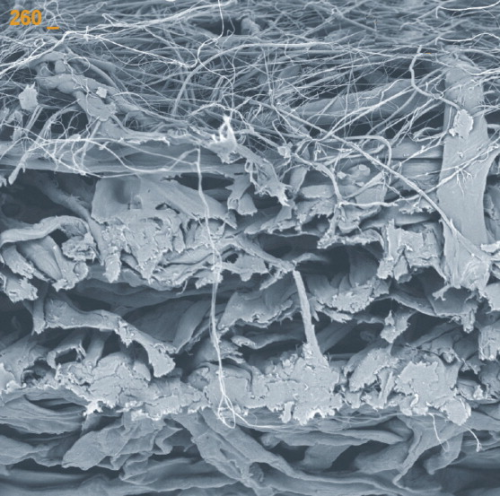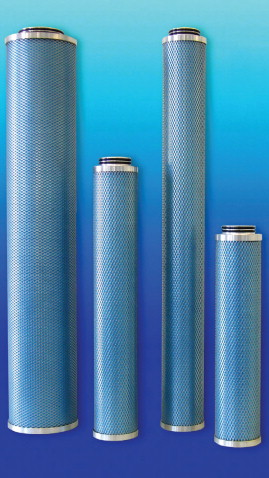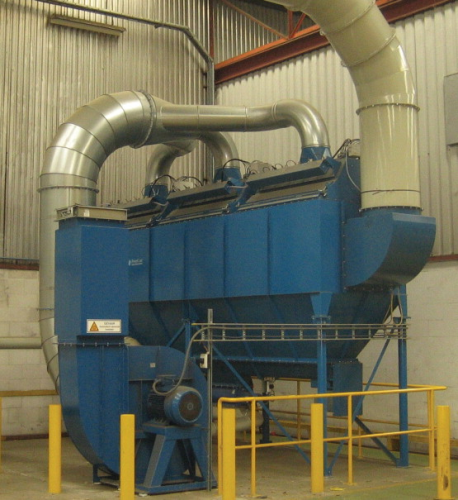



This article looks at the changing focus of legislation that Europe and the US have put in place to tackle climate change and how this has driven air filtration innovations to meet energy efficiency targets alongside the requirement for finer levels of separation. Various technologies from two leading manufacturers are presented and an industrial filtration case study from the Netherlands is included.
Energy efficiency versus finer separation
In all air and gaseous filtration applications, the pressure drop in the process stream as it flows through a filter represents an energy loss, which has to be made up by the overall system resulting in an energy cost. The higher the pressure drop, or delta pressure, the higher the energy requirement for the filtration and separation system. This is especially true in large volume applications, such as dust collection systems on industrial applications, gas turbine air intakes or process exhausts. In addition to the economic implications of this energy loss, there are strengthening legislative pressures at a global level on industrial activities to use as little energy as possible.
In the case of filtration, the drive towards a more efficient use of energy directly opposes the major driving force to provide increasing degrees of separation to satisfy more and more advanced industrial processes. These competing demands are not easily reconciled because filters that separate more efficiently have traditionally needed higher pressure drops to do so.
However, much activity over the last couple of years has been put into research and development to produce filters with lower intrinsic pressure drops at finer levels of separation, many such designs using products independently developed by Hollingsworth & Vose Company and Donaldson. It is now common to see new product announcements including phrases like ‘energy saving' or ‘very low resistance to flow'. Advances and innovations are described in the following sections where we look at automotive and other industrial air filtration industries.
Research and development activity has been driven by legislative changes put in place by developed countries in an attempt to mitigate some of the effects of climate change by reducing greenhouse gas (GHG) emissions. In Europe, for example, the UK government has set a statutory target to reduce carbon dioxide emissions by 26% by 2020, based on 1990 levels, and decrease all GHG emissions (including those from the aviation and shipping industries) by 80% by 2050. Following this European lead, in the first half of 2010 the Obama Administration in the US took steps towards the target of reducing US oil consumption by 35% by 2030, with an associated expected reduction in GHG emissions. Following the recent Deepwater Horizon accident and oil spill, and the resulting environmental catastrophe in the Gulf of Mexico, the Obama Administration has promised to push through a new moratorium on offshore drilling. The effects of the oil spill are obviously wide reaching and are likely to accelerate the pace of change towards the US oil reduction target and drive more energy reducing measures, especially in the automotive industry.
In response to this new legislative and political framework, vehicle manufacturers have started accelerating the implementation of new power train technologies. They are now actively redesigning many aspects of vehicle exteriors to improve aerodynamics, and reducing overall vehicle weight to reduce friction, increase fuel economy and increase energy efficiency.
Each of these actions in turn intensifies the need for higher performance air filtration media, filter designs and overall system design. With the latest advances in filter media technology and filter media processing, innovative filtration products are now enabling system designers to decrease their operating costs, obtain significant energy cost savings, provide a performance increase and comply with the highest quality standards.
Innovations
Automotive filtration
As a result of the drivers identified above, Hollingsworth & Vose Company, a filter media developer and manufacturer, has introduced two new families of automotive air induction products, Capaceon™ media and NANOWEB® media, which specifically address the growing need for higher unit filtration capacity and higher efficiency at a lower media delta pressure.
The common mobile engine air intake filter has changed in recent years from a flat circular array of pleated filter medium to the ‘flat' panel automotive filter and the tall radial commercial vehicle filter. New requirements often mean ‘common' is no longer enough.
Andrew Shepard, Director of Global Market Management at Hollingsworth & Vose, told us that new powertrain technologies, more efficient and lower aerodynamic lines at the front of vehicles, and bigger cooling packages implemented to meet higher fuel economy standards, have resulted in automotive manufacturers leaving less and less room in the engine compartment for air filters.
Shepard said: “Our new filter media can help manufacturers design filtration systems in a variety of shapes and sizes to fit today's engine compartments or new positions outside normal locations.”
Capaceon is a new category of high-performance automotive air filter media that maintains current media cost of ownership but breaks the traditional link between basis weight and media performance. Hollingsworth & Vose claims that both the water-based and solvent-based versions of Capaceon media offer 20-50% higher dust-holding capacity and improved initial efficiency at equal basis weights compared to current media used in the market. This creates more value for customers by offering a higher level of engine protection and a longer service interval. Combined with extra water resistance, the media enables higher performance in smaller, more flexible packages. Also, smaller air induction systems, which can be placed in less-desirable vehicle locations, help designers reduce vehicle weight through more efficient design and improved vehicle aerodynamics.
To meet the GHG reduction requirements already identified, new vehicles will effectively need to clean the environment, actually emitting lower particulate concentrations in exhaust gases than were present in the air intake. Soot particles, typically in the 60 nm to 100 nm range, in the air intake shorten the life of most filters. Major medium and heavy-duty truck filter manufacturers have chosen Hollingsworth & Vose NANOWEB media in their filters because real-world tests have demonstrated the technology improves equipment protection, extends filter service intervals and has a lower filter delta pressure than other standard media. NANOWEB media provides both a lower initial pressure drop and higher fractional efficiency. NANOWEB media's durable 0.3-0.5 μm fibres filter out ultrafine particles, like soot, while being remarkably resistant to clogging, which significantly improves service life. The total cost of ownership can be reduced whilst directly contributing to achieving the new environmental regulations.
A scanning electron micrograph cross sectional image of NANOWEB media on a cellulose substrate is shown in Figure 1.
Most vehicles use Mass Air Flow (MAF) sensor outputs to optimise engine combustion and meet fuel economy and emissions regulations. Solvent-based NANOWEB media for automotive air applications was specifically designed for large engine displacement, light-duty applications where oil has been traditionally added to the filter media to meet high capacity requirements. Designing NANOWEB media into these filter applications removes the need for oil by directly increasing element service intervals. This minimises fouling of the sensitive MAF sensors and other electronics which in turn helps engines maintain optimised fuel economy and emissions performance. Hollingsworth & Vose also offers NANOWEB media for on-road and off-road heavy duty air filter applications as well as for larger scale gas turbine and dust collection systems.
Industrial filtration
The two most common forms of air or gas filter are the cylindrical cartridge or ‘bag' filter, and the 'flat' panel filter, mounted in a dividing wall or plenum chamber. The flat panel systems tend to be used in heating, ventilation and air conditioning (HVAC) systems in commercial and industrial applications.
Bag filters are commonly used in larger scale industrial air filtration systems. The cylindrical cartridge or bag is located in a cylindrical housing, a series of which form a ‘baghouse' system. The air flow is through the bag from outside to in, so that separated solids accumulate on the outside, from which they can be blown by a reverse pulse of compressed air. Although generally giving way to nonwoven media, woven fabrics still have an important role in baghouses because of their ability to flex during the reverse pulse. Hence, they can break the accumulated dust cake, allowing it to fall away from the bag.
Donaldson, a leading worldwide provider of filtration systems and replacement parts, has recently introduced Synteq XP® compressed air filter media, which the company claims increases efficiency considerably whilst reducing energy consumption due to a much lower media delta pressure, achieving energy savings of up to 40% (see Figure 2). The new filter medium combines a unique fibre blend and a new manufacturing technique that does not require a binder.
Donaldson claims that end users can save a ‘three-to-four digit Euro sum' on energy costs per annum. Furthermore, assembly and servicing have been simplified through specially designed filter housings. The advantages were confirmed by examination of performance data in line with the ISO 12500-1 standard, which showed that at a flow rate of 1,100 m3/h more than €1,500 per annum could be saved. This was well in excess of the costs of the filter, even allowing for the cost of the filter housing.
This savings potential is also demonstrated by PowerCore® dust collection technology, which Donaldson says is superior to conventional bag filter units and leads to substantial reductions in operating costs. The Donaldson units using this new technology are up to 70% smaller than conventional dust collectors. For example, a dust collection unit previously equipped with 81 bag filters of 2.40 m in length, has been replaced by only 12 PowerCore filter packs. Ten minutes was required for replacing a traditional bag filter, compared to two minutes to replace the fewer PowerCore filters. The replacement of the filter packs is a remarkably clean process and therefore very service-friendly.
Donaldson was able to transfer experience of air intake filter design for heavy duty vehicles to the development of the company's dust collection technology. PowerCore filter packs combine advanced filter manufacturing techniques with patented Ultra-Web® nanofibre technology. The filter media, shaped similarly to intake filters, is formed into fluted channels and layered so a rugged structure is produced. This allows a higher dust load to collect on the surface of the media flutes than would be possible with conventional filter fibres, with a depth loading of 540 g/m2 for standard polyester. This high surface filtration performance combined with a patented pulse cleaning technology leads to the performance increase.
For years, the filtration industry has been looking for a synthetic alternative to glass mat media that offers better filter performance with lower energy costs. To solve this challenge, Hollingsworth & Vose Company designed and developed NanoWave™, an environmentally-friendly all-synthetic extended surface, high-loft material (see Figure 3). Developed for the ASHRAE (American Society of Heating, Refrigerating and Air Conditioning Engineers) -certified HVAC bag filter media market, the material has three times the dirt holding capacity of conventional media.
NanoWave is the only synthetic media that equals or exceeds the performance of glass mat after discharge. Unlike conventional synthetic media, which rely on electrostatic charge, NanoWave is a mechanical filter that meets the same efficiency at half the resistance in a discharged condition with no performance decay throughout filter life. Where extra high efficiency and low pressure drop are required, NanoWave media can be electrostatically charged. The significantly lower pressure drop for a given efficiency results in lower energy consumption for air handling equipment.
Hollingsworth & Vose's innovative NanoWave synthetic media also improves filter manufacturing, installation productivity and clean disposal compared to traditional synthetics. Designed specifically to meet ASHRAE bag standards, NanoWave media can be converted into filters using conventional ASHRAE bag manufacturing equipment, such as conventional sewn and ultrasonics, eliminating capital expenses for switching plant equipment.
NanoWave media provides glass mat levels of performance without the concerns for fibre shedding during filter processing, installation, and use that is associated with glass media. NanoWave media's high stiffness allows proper bag opening, and it retains its shape in variable HVAC systems, reducing set-up time and increasing productivity. The media's design also allows for incineration and low impact disposal leading to reduced pressure on the environment. These benefits increase the product value from filter production through filter installation to final replacement.
Case study - Mineral wool insulation
The PowerCore technology described has been applied at Isover, a mineral wool insulation production factory in Holland (see Figure 4). Isover replaced its tubular bag filters with a compact PowerCore unit.
Plugging and clogging is a common problem when dust collection units are employed in the mineral wool insulation production process. The fibres tend to entangle and bridge, and when they are taken out of the melting-oven they can stick together.
Project Engineer René van Gurp at Isover said: “When the existing filter at the cutting and stacking station of one production line was at the limit of performance, we wanted to install a new baghouse dust collector.”
Isover agreed to test the new PowerCore technology before the official European market launch. René van Gurp said: “During a 400 hour test the filter did not clog or plug one single time, the pressure drop stabilised at a steady 25 Pascals and we were impressed with the cleanliness of the clean air side of the filter chamber.”
After six month's operation the engineers at Isover remain satisfied with the results. René van Gurp commented: “There is no significant increase in pressure drop so we expect the filter packs to reach more than the expected lifetime of one year. Not once did we have a downtime due to a plugged filter on that production line.”
The PowerCore units were engineered with computer-modeled fluid flow analysis to manage the incoming dust-laden air and the velocities directed into the filter pack, avoiding bridging problems between the filter packs. Hot glass fibres that virtually glue together are efficiently prevented from building agglomerations. The pulse pattern of the Compact Oblique Pulse Cleaning System covers the entire media pack and pulses the dust out of the fluted channels. Bridging and plugging is, therefore, successfully avoided.
Conclusions
Some of the latest advances in filtration technology are based on new developments in filter design and media technology, driven by legislative responses to climate change and increasing GHG emissions. Innovative filtration products are now enabling filtration system designers and plant managers to decrease their operating costs and realise energy cost savings whilst complying with the highest quality standards to obtain a performance increase. We have investigated various advances in air filtration technologies for industrial applications, including automotive and other industrial applications, profiling innovations such as Capaceon, NANOWEB, NanoWave, Synteq XP, PowerCore and Ultra-Web technologies. It is likely that delta pressure levels will reduce further over coming years as increasing filtration efficiencies are required, the pressure to meet more environmental demands grows and new innovations, such as further developments in nano technology, are brought to market.






